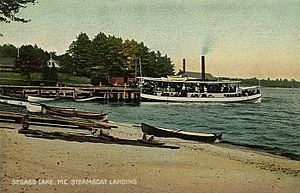Cumberland and Oxford Canal facts for kids
Quick facts for kids |
|
|
Cumberland and Oxford Canal
|
|

A canal section in Windham
|
|
| Location | Cumberland County, Maine |
|---|---|
| Area | 1,475 acres (597 ha) |
| Built | 1832 |
| NRHP reference No. | 74000317 |
| Added to NRHP | November 1, 1974 |
The Cumberland and Oxford Canal was a special waterway built in Maine. It opened in 1832. Its main job was to connect the big lakes in southern Maine with the important seaport of Portland.
The canal followed the Presumpscot River for a long way. It went through towns like Standish, Windham, and Westbrook. From Westbrook, it turned towards the Fore River and Portland Harbor.
To help boats travel uphill to Sebago Lake, which is 267 feet (81 m) above sea level, 27 special water elevators called locks were built. One more lock was added on the Songo River. This extra lock helped boats reach Long Lake from Sebago Lake. The total distance boats could travel was about 38 miles (61 km) from Portland to Harrison.
To pay for the canal, a state lottery was held. It helped raise $50,000. The Canal Bank of Portland was also started in 1825. The canal was finished in 1830 and cost $206,000.
The parts of the canal that were dug out were 30 feet (9.1 m) wide at the top. The water channel itself was 10 feet (3.0 m) wide and 3.5 feet (1.1 m) deep. The locks were 10 feet (3.0 m) wide and 80 feet (24 m) long. Their walls were made of strong granite stone. Each lock had wooden gates at both ends. A lock keeper worked at each lock. They would move the gates and change the water levels. They also collected a small fee of 6 cents from each boat.
How Canal Boats Worked
The boats used on the canal were flat-bottomed. They had blunt fronts and square backs. They only needed about 3 feet (0.91 m) of water to float. Next to the dug-out parts of the canal, there was a path called a tow path. Here, horses would pull the canal boats. Boatmen would steer the boats with long poles.
Boats that traveled on the lakes were a bit different. They had a part called a keel that could be taken off. They also had two short masts that could be folded down. This allowed them to use sails on the lakes or fold the masts to pass through the narrow canal sections.
Many different goods were carried on the canal. From the inland areas, boats brought things like lumber, wood for barrels, and firewood to Portland. Apples were also a very important crop from the region. Near the canal in Windham, the Oriental Powder Company made a lot of gunpowder. They produced almost 25% of the gunpowder used by the Union army during the American Civil War.
People could also ride on the canal boats. Passengers paid half a cent for every mile they traveled. From Portland, the boats carried many different manufactured goods inland.
There's a local story about the south end of Long Lake. It's called Brandy Pond because a barrel of brandy fell off a canal boat there a long time ago!
The End of the Canal Era
Over time, railroads became a new way to move goods. In the 1850s, freight from Oxford County started moving on the Atlantic & St Lawrence Railroad. This meant less business for the canal.
By 1870, a railroad reached Sebago Lake Station. Because of this, the 18-mile (29 km) long part of the canal along the Presumpscot River was not used much anymore. Some of the old canal lock areas were changed into dams for a paper mill.
Even though the canal was used less, steamboats still used Songo Lock. They carried people from Sebago Lake Station to towns around the lakes, like Bridgton and Naples. More railroads were built, reaching Bridgton in 1883 and Harrison in 1898.
Steamboat companies continued to offer summer trips for tourists. The last steamboat, named Goodrich, sadly burned in 1932. Today, Songo Lock is still used by people in pleasure boats.
Images for kids






